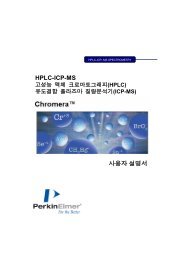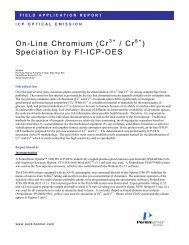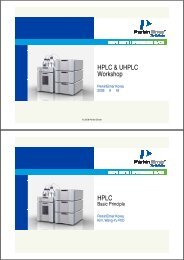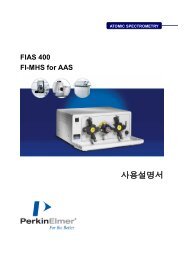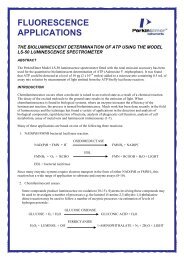Conclusion Get more connected.
Conclusion Get more connected.
Conclusion Get more connected.
Create successful ePaper yourself
Turn your PDF publications into a flip-book with our unique Google optimized e-Paper software.
FT-NIR SPECTROSCOPY<br />
application note<br />
The Determination of OH Number in<br />
Polyols Using FT-NIR Spectroscopy<br />
Summary<br />
NIR spectroscopy is an invaluable tool<br />
for the quantitative analysis of a wide<br />
range of chemical compounds. In<br />
combination with a number of<br />
chemometric methods, the technique<br />
provides a fast, non-destructive route<br />
to the determination of physical and<br />
chemical properties.<br />
This note describes the use of<br />
FT-NIR spectroscopy in a typical<br />
polyol analysis with an outline of<br />
the development of the quantitative<br />
method used for the application.<br />
Introduction<br />
Polyols are long-chain polymers<br />
which contain alcohol functional<br />
groups and are produced via<br />
reactions involving organic oxides,<br />
acids and multi-functional alcohols.<br />
A wide range of products<br />
including, surfactants, foams, paint<br />
additives, and adhesives are<br />
manufactured using polyols. The<br />
production of polyurethanes, for<br />
instance, involves polyol<br />
intermediates.<br />
Polyol products are typically<br />
produced via batch reactor processes<br />
held at high temperatures (>250˚C).<br />
Current analysis of the polyols<br />
produced normally take the form of<br />
back titrations. The resultant OH<br />
number is an average value over a<br />
number of titrations.<br />
This analysis generally takes<br />
place in an off-site laboratory, often<br />
far removed from the conditions<br />
present at the production site. The<br />
sample is extracted from the bulk,<br />
and the production process halted<br />
while the analysis is completed; a<br />
process that can take several hours.<br />
Care must be taken in handling the<br />
chemicals involved, especially when<br />
analyzing samples at elevated<br />
temperatures. The possibility of<br />
moisture being absorbed from the air<br />
is highly detrimental to the analysis<br />
of the OH value. A system whereby<br />
the sample must be heated is applied<br />
if the sample is a solid or highly<br />
viscous liquid. Even when all these<br />
factors have been minimized or<br />
taken into account, the process still<br />
depends on the analyst. The current<br />
method for determining OH number<br />
is expensive, time consuming, and<br />
prone to human error.<br />
A typical NIR based application<br />
is faster, <strong>more</strong> precise and reliable<br />
than other methods. It also reduces<br />
the need to handle potentially<br />
hazardous substances. The bands in<br />
the NIR region (ca. 15000 – 3000<br />
cm-1, 667 – 3333 nm) are primarily<br />
overtones and combination bands<br />
normally associated with C-H, N-H<br />
and O-H bonds. Since organic<br />
polymers are composed of carbon,<br />
hydrogen, nitrogen and oxygen<br />
atoms, the NIR spectra of polymers<br />
feature sharp, strong absorbance<br />
bands.<br />
Polymer manufacturers can use<br />
NIR spectroscopy to perform<br />
analyses on the production site.<br />
This has obvious advantages in the<br />
area of quality assurance. NIR<br />
analysis is also capable of process<br />
control as the analysis of<br />
intermediates occurs in real-time.<br />
Since many polyol reactions are<br />
irreversible, the analysis of such<br />
intermediates by NIR spectroscopy<br />
provides a commercially valuable<br />
tool.<br />
A typical NIR method<br />
development for OH determination<br />
consists of first assembling a set of<br />
preanalyzed samples which must<br />
span the OH range for which the<br />
calibration is intended. The number<br />
of samples used depends on the OH<br />
range and accuracy required, but for<br />
most applications in the range ca.<br />
20 – 200 OH approximately 20<br />
samples are adequate for calibration.




